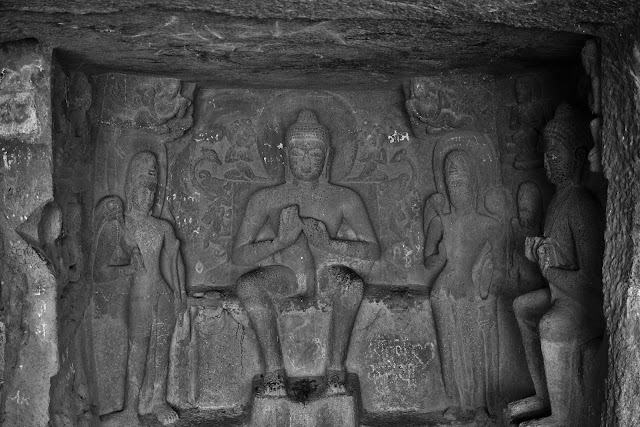A few days back in the month of September 2018, I travelled to this beautiful city among the Vindhyas Range of Western Ghats.
 |
| Nasik City. |
It was after ages, I travelled in a train by the name of Dadar express, which travels from Amritsar to Dadar Station, Mumbai, a distance of more than 2000 km. As I was travelling from one breadth of India to another extreme of India I could see the beauty of India which only a train experience can give and show the beauty and diversity of India. The travel through Madhya Pradesh was quite something but for me most interesting was the lyrical names of the stations in Madhya Pradesh like Khandwa, Chadni, Hosagnabad, maybe, for this reason, Madhya Pradesh was one of the largest centres of Hindusthani Music. Coming back to my train travel, I must mention to you it was quite surprising from me that a train which travels for more than 2000 km does not have a pantry car and we had to rely on catering provided at different stations.
After finishing my work for which I came to Nasik and having a lot of time to spare, I decided to visit the famous Panadaveni Caves or known as the Nasik Caves and it was one of the reasons of going to Nasik. Panadaveni Caves are a group of rock-cut caves which belong to the genre of Indian rock-cut architecture.
The Pandaveni Caves or known as Pandu-Lena Caves/Pandava Caves /Trirasmi Caves is a group of 24 rock-cut caves in the North and North – East direction and is located in the North Face of the Trirasmi Hill (8 km from the Nasik City) and were donated to Theravadin and Mahayana Sects of Buddism by various rulers like the Satavahana Kings, the Kshatrap Nahapana, the Abhir Kings and by various merchants and common people. The said caves have been estimated to be built during the 2nd Century AD/CE and were said to be discovered/first described by Captain James Delamaine in 1823.
 |
| Royal Buddha. |
 |
| Buddha as a royal figure. |
 |
| Intrinsic Carvings |
 |
| Apprecitng in SIlence. |
 |
| Carvings on the rock cut temple. |
 |
| Chaith - Prayer Hall. |
Apart from the Pandu-Lena Caves/Pandava Caves /Trirasmi Caves, there is also the Trimbakeshwar or Tryambakeshwar, an ancient Hindu temple which is dedicated to Lord Shiva and Kalaram Temple, but sadly no pictures are allowed. Seriously, someone this practice that you cannot photograph the old ancient temples has to be stopped.
As, I was leaving Nasik, something just crossed my mind that Nasik has been for some reason one of the most important places in Indian subcontinent and is also a very ancient place as it has mentioned in the Epics of India and played a very important role in the Freedom Movement of India and the Dalit Movement of India. Geographically, one of the main rivers of India, the majestic Godavari River which starts as an underground and crosses about 8 states and then joins in the Bay of Bengal and is one of the main sources of irrigation starts in Triambakeshwar area (which is considered part of the Nasik region and is about 35 km from the Nasik city). Myth logically, it is said that Ram, Sita and Laxman in the Panchavati area of Nasik City when they were exiled for 14 years and that Sita was abducted from there, which was one of the turning points of the Epic Ramayana and it is also said that Hanuman was born/conceived in the region of Nasik. Nasik also has the famous “Kalaram Temple”, where Ram, Sita and Laxman are in black in colour. Further, the Trimbakeshwar or Tryambakeshwar, an ancient Hindu temple which is dedicated to Lord Shiva and is one of the twelve Jyotirlingas is situated in Triambakeshwar area (which is considered part of the Nasik region and is about 35 kms from the Nasik city). One of the unique features of Jyotirlingas is situated in Triambakeshwar is that inside the Jyotirlingas are three faces embodying/representing Lord Brahma, Lord Vishnu and Lord Rudra. Historically, it is where the famous rock-cut caves known as Pandaveni Caves. is situated which was built in between the 1st century – 2nd century BC. Nasik also played and continues to play a very important role in the Dalit movement of India, which dates back to 1930 and the most famous being the “Kalaram Temple Entry Satyagraha, At. Nasik (1930-1934)” for the right of Dalit to enter Hindu temples. At present Nasik also continues to be of the centres of Dalit movement and farmland movement in India like the historic walk of 25,000 farmers from the Nasik region to the city of Mumbai in the month of March 2018. Nasik is also the birthplace of Dadasaheb Phalke, one of the pioneers and greats of Indian Cinema (more specifically in Triambakeshwar).
Just a note that I was leaving Nasik via a superfast train which stops at mere 4 to 5 stations does not have any pantry. The Indian Railways should come up with a uniform policy that trains which go for more than 1000 km should compulsorily have pantries.







No comments:
Post a Comment